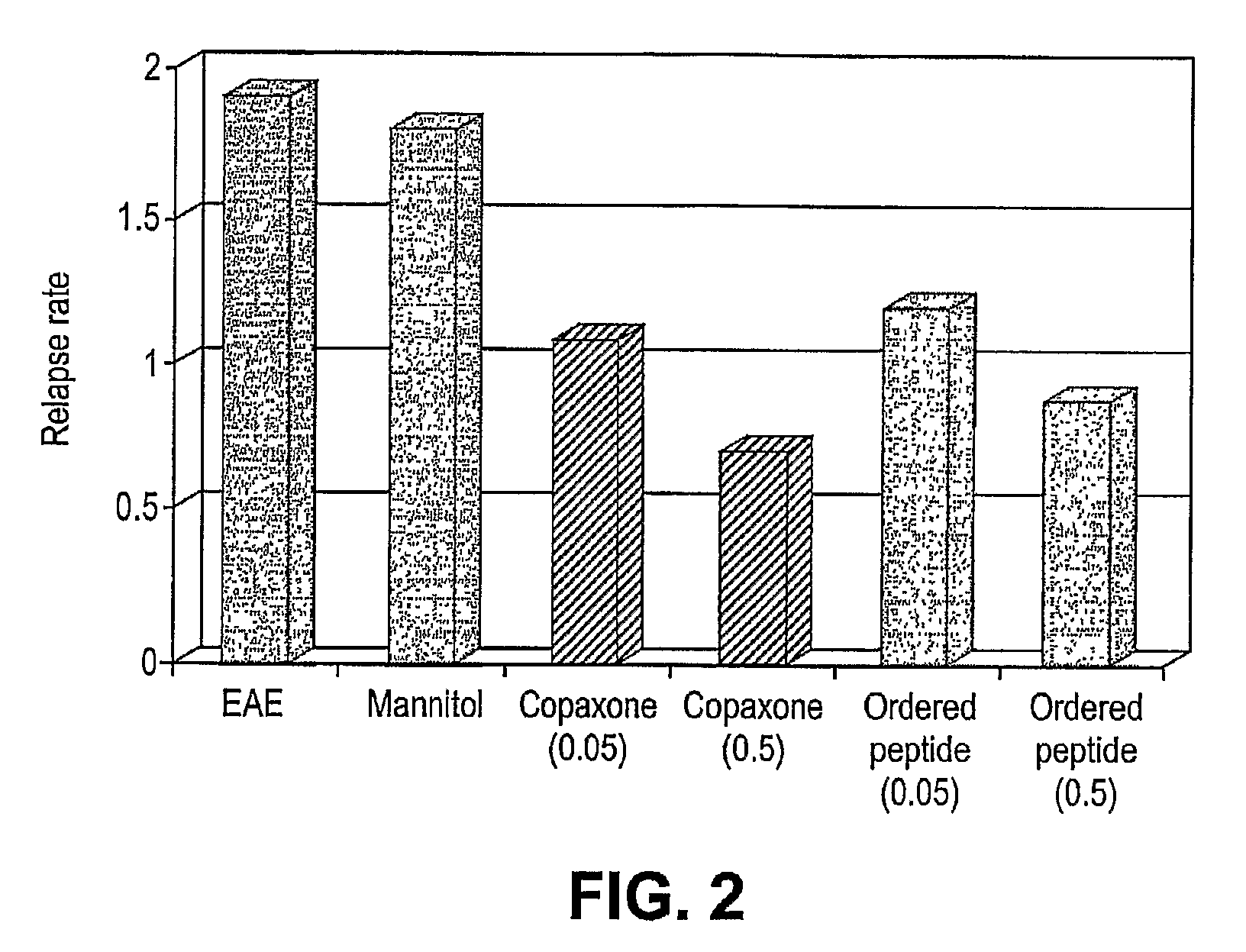Treatment of demyelinating autoimmune disease with modified ordered peptides
a technology of demyelinating autoimmune disease and peptides, which is applied in the direction of peptide/protein ingredients, peptide sources, immunological disorders, etc., can solve the problems of visual acuity disturbance, pain, touch loss, etc., and achieve the effect of enhancing the autoimmune suppressive effect of treatmen
- Summary
- Abstract
- Description
- Claims
- Application Information
AI Technical Summary
Benefits of technology
Problems solved by technology
Method used
Image
Examples
example 1
Therapeutic Ordered Peptides for Immunomodulation Based on MHC-TCR Binding Motifs
[0060]The region between the amino acids 85 to 99 of myelin basic protein (MBP) contain the immunodominant epitope for T cells and autoantibodies in MS brain lesions. The main region of MBP recognized by T cells and autoantibodies, found in MS brain, is the core motif, {SEQ ID NO:8} HFFK, from MBPp87-99 in patients who are HLA DRB1*1501 DQB1*0602 (HLA DR2).
[0061]Previously, we have compared the structural requirements for autoantibody recognition to those of T cell clones reactive to MBP p87-99. Anti-MBP antibodies were affinity-purified from CNS lesions of 12 post-mortem cases studied. The MBP p87-99 peptide was immunodominant in all cases and it inhibited autoantibody binding to MBP by more than 95%. Residues contributing to autoantibody binding were located in a 10-amino acid segment p86-95 ({SEQ ID NO:9} VVHFFKNIVT) that also contained the MHC-T cell receptor contact residues for T cells recognizing...
example 2
MHC Blockade and T Cell Antagonism of MBP Therapeutic Ordered Peptide in EAE
[0068]A clear structural relationship between an autoimmune MHC-peptide complex and disease has not been demonstrated. Nevertheless, binding of peptides to the MHC has been extensively used as a parameter to select immunodominant sequences. Our results demonstrate a comparable amount of inhibition of binding of MBP peptide to rat MHC class II or PLP peptide to mouse MHC class II when either the therapeutic ordered peptide EYYK, the modified therapeutic ordered peptide, D-ala-EYYK, or glatiramer acetate were present in the reaction (FIG. 3). These results show that the modified therapeutic ordered peptide D-Ala EYYK appears to have a higher affinity of binding to these MHC's than the unmodified EYYK, and approaches the binding achieved by Copaxone. Assays where inhibition of peptide-MHC binding by related structures is tested have been use to explain the mechanism of action of MHC blockade as a therapeutic to...
example 3
Preparation of Modified MBP Therapeutic Ordered Peptide and Effect in EAE
[0071]The ability of therapeutic ordered peptide EYYKEYYKEYYK, modified therapeutic ordered peptide D-Ala-EYYKEYYKEYYK-amide, or Copaxone to treat a rat model of EAE was tested. A single 0.5 mg dose of each of these peptides was administered along with the encephalitogen (MBP 85-99 peptide in CFA) as an emulsion. As shown in FIG. 5 the results, expressed as mean disease score of 12-13 animals, demonstrate surprisingly the superiority of the D-Ala form of the ordered peptide over the non-substituted form. The D-ala form nearly reaches the efficacy of Copaxone in this model.
PUM
| Property | Measurement | Unit |
|---|---|---|
| molecular weights | aaaaa | aaaaa |
| concentration | aaaaa | aaaaa |
| concentration | aaaaa | aaaaa |
Abstract
Description
Claims
Application Information
 Login to View More
Login to View More - R&D
- Intellectual Property
- Life Sciences
- Materials
- Tech Scout
- Unparalleled Data Quality
- Higher Quality Content
- 60% Fewer Hallucinations
Browse by: Latest US Patents, China's latest patents, Technical Efficacy Thesaurus, Application Domain, Technology Topic, Popular Technical Reports.
© 2025 PatSnap. All rights reserved.Legal|Privacy policy|Modern Slavery Act Transparency Statement|Sitemap|About US| Contact US: help@patsnap.com



